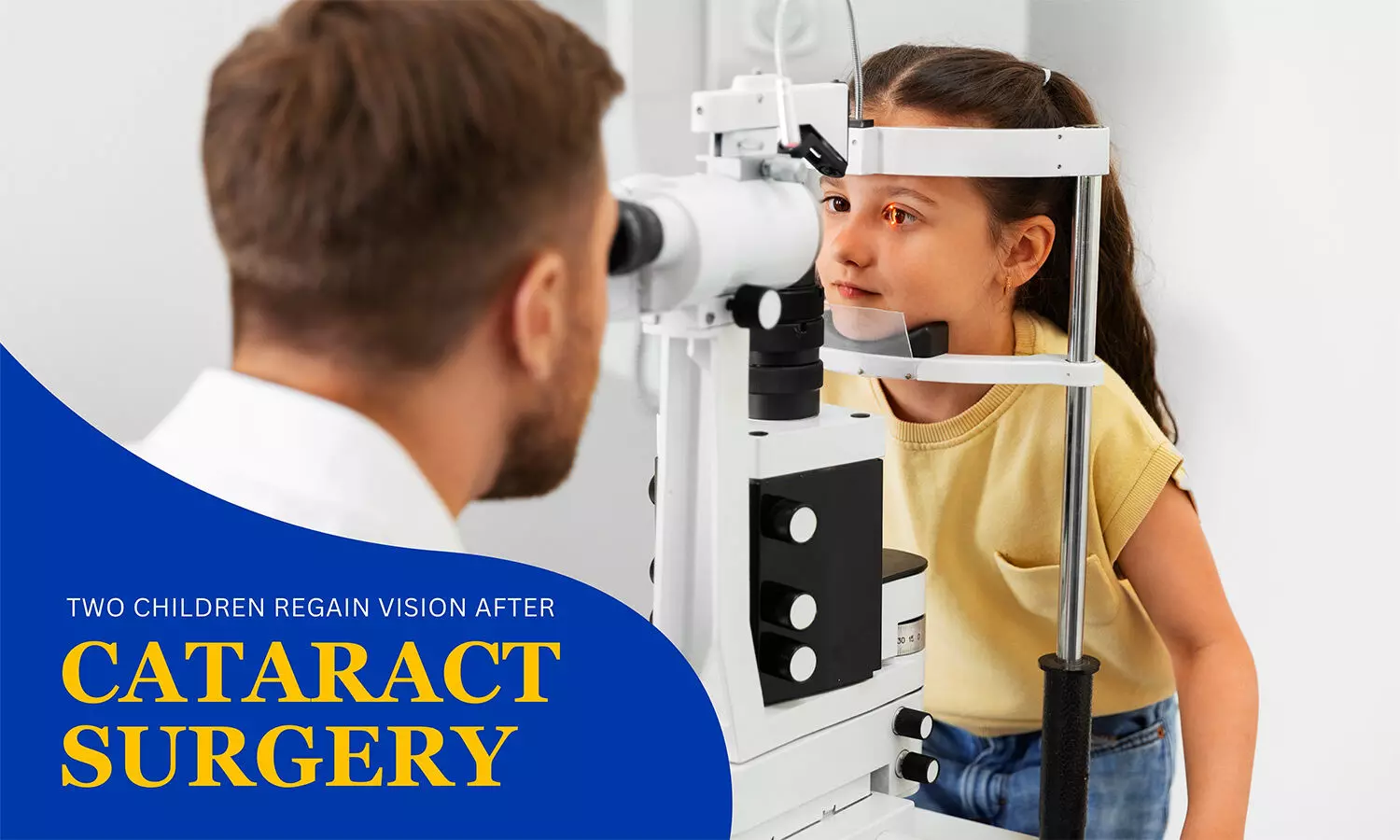Live
- India Faces Blow as Pacer Mohammed Shami Ruled Out for Remainder of Australia Series
- Biden Pardon: Joe Biden Commutes Death Sentences of 37 Inmates, Including Child Killers and Mass Murderers
- South Korea: Yoon believes impeachment trial takes priority over martial law probe
- Strict Action for Non-Adherence to Time Management - DMHO Dr. Swarajya Lakshmi
- Over 13.29 lakh houses approved for rural poor in Maharashtra: Shivraj Chouhan
- District Collector Urges Timely Completion of Indiramma Housing Scheme Survey
- Digital Arrest Scam: Hyderabad Man Duped of ₹7 Lakhs by Fake Crime Branch Police Callers
- Sukhbir Badal seeks President's Police medal for officer who saved his life
- US Firm Accordion Acquires Merilytics, Launches 1,500-Seater Office in Hyderabad
- Free Medical Camp Organized by Alampur Advocate Bar Association
Just In
Two Children Regain Vision After Cataract Surgery


Two Children Regain Vision After Cataract Surgery
Two children have regained their vision after undergoing cataract surgery at a government hospital. Learn how cataract surgery restores sight and transforms lives.
In a remarkable turn of events, two young children have regained their vision following successful cataract surgeries performed at a government hospital. This news not only brings joy to the families involved but also highlights the incredible advancements in modern medicine, particularly in the field of eye care. Cataract surgery, a procedure often associated with older adults, has proven to be life-changing for children. It shows that vision loss can be reversed when diagnosed and treated promptly.
A Life-Changing Procedure: Restoring Sight in Children
For the families of these children, the experience of seeing their loved ones regain their vision was nothing short of a miracle. When cataracts occur in young individuals, it can severely impact their ability to engage in daily activities, education, and socialisation.
The successful surgeries are a testament to the skills of the doctors and medical staff, as well as the importance of accessible healthcare services, even at government hospitals. The procedure not only restored vision but gave these children a new lease on life, allowing them to explore the world with clarity and confidence once again.
Understanding Cataracts: What They Are and Why They Matter
Cataracts are typically associated with ageing, where the eye’s natural lens becomes cloudy, resulting in blurred vision or even blindness if left untreated. However, cataracts can also occur in children, a condition known as congenital cataracts. These can be present at birth or develop early in life, sometimes due to genetic factors, infections during pregnancy, or trauma to the eye.
In children, early detection is crucial. Untreated cataracts can lead to permanent vision impairment as the developing brain fails to receive clear visual signals. The visual system requires proper stimulation during infancy and childhood to fully develop, which is why timely medical intervention is critical.
Importance of Early Diagnosis and Treatment
For these two children, the timely diagnosis and treatment were crucial factors in the success of their surgeries. Parents and caregivers must be vigilant in recognising early signs of vision problems in children, as younger patients may not always be able to articulate their difficulties. Symptoms of cataracts in children can include
- Cloudy or blurred vision
- Sensitivity to light
- Trouble focusing
- A whitish or grey appearance in the eye
- Difficulty tracking objects or maintaining eye contact
Paediatric eye exams are essential, particularly in the early stages of life, as they allow doctors to identify conditions like cataracts before they cause irreversible damage.
Cataract Surgery
Cataract surgery is a highly effective procedure for restoring vision. The surgery involves removing the cloudy lens from the eye and replacing it with an artificial one, known as an intraocular lens (IOL). In children, the surgery requires special care due to their developing eyes, but advancements in technology and medical expertise have made it possible to perform this procedure safely and successfully, even in very young patients.
The success stories of these two children highlight how accessible and reliable cataract surgery has become. The procedure itself is relatively quick, often taking less than an hour, and the recovery period is usually smooth. Most patients experience significant improvements in their vision within a few days. In the case of children, postoperative care is particularly important to ensure the eyes heal correctly and to monitor for any complications.
Advancements and Future Possibilities of Cataract Treatments
The success of these surgeries also highlights the broader advancements in cataract treatment. In recent years, cataract surgery has evolved significantly, with new technologies and techniques making it safer, more effective, and accessible to a broader population. Some of the recent advancements include
1.Laser-Assisted Surgery - This method uses lasers to perform certain steps of the surgery with even greater precision, reducing the risk of complications and improving recovery times.
2.Advanced Intraocular Lenses (IOLs) - IOLs have also seen major improvements, with specialised lenses that can correct other vision problems, such as astigmatism, in addition to cataracts.
3.Minimally Invasive Techniques - Surgeons now have the tools to perform cataract surgery using smaller incisions, which leads to faster recovery and less discomfort for patients.
The Road Ahead- Raising Awareness and Expanding Access to Care
The success of these two children’s surgeries is a heartening example of what can be achieved through early diagnosis, advanced medical care, and the dedication of healthcare professionals. However, it also highlights the importance of raising awareness about paediatric cataracts and other eye conditions. Many children around the world suffer from preventable or treatable vision impairments simply because their conditions go undiagnosed or they lack access to proper medical care.
Governments, healthcare providers, and communities must work together to ensure that all children have access to eye care services, regardless of their socio-economic background. Public awareness campaigns, routine paediatric eye exams, and continued investment in public healthcare systems are crucial steps toward preventing vision loss in children.

© 2024 Hyderabad Media House Limited/The Hans India. All rights reserved. Powered by hocalwire.com






